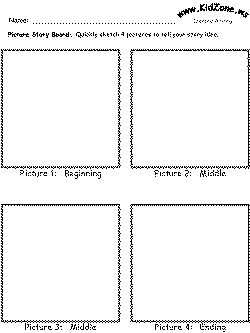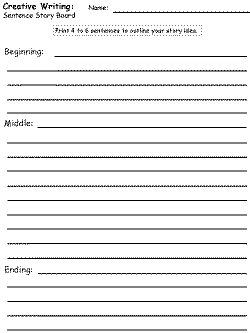KidZone: Creative Writing
Write Stories/Making Books
Introduction:
Most children have a natural creative streak, but as anyone who has tried it knows, getting an idea out of your head and onto a piece of paper can be very challenging! Of course, the most challenging exercise is for the children to develop their own stories out of thin air.
They can create their own tools to help them through this sometimes difficult process. I've provided some templates for the children to use when creating these tools and for the children to use when creating the final draft of their book.
You can use all of the templates or select ones. I've listed them in the order I would provide them to the child.
Printable Templates:
Before you start writing:
- Ask Yourself! Come up with 5 questions to ask yourself about your story. Answer your questions.
- Picture Story Board Quickly sketch 4 pictures to outline your story idea.
- Sentence Story Board Print 4 to 6 sentences to outline your story idea.
Write a rough draft: Use lined paper to print a rough draft of your story.
Editing:
- Self Edit: Set your rough draft aside for at least a
day. Then read through your story looking for:
- plot development (beginning, middle and end), character development, setting, juicy words (adverbs and adjectives), grammar, spelling, and punctuation.
During self edit, it's best to read your story through editing for a different component each time (in other words, don't try to fix your plot development and your spelling at the same time).
- Peer Edit: Have one of your classmates read through your story, providing comments and corrections.
- Adult Edit: Have a teacher or parent read through your story, providing comments and corrections.
Final Draft
Use full page or half page templates to print your story. Add illustrations.
You can do a cooperative project by having one student act as author and another as illustrator. Having a Picture Story Board for the author to give to the illustrator can help the process. Or you can have the children swap authored books and let them illustrate each others. Having a different author/illustrator teaches the children how people collaborate to publish books.
- Full page templates
- Half page templates
"Publishing"
Provide shelf or cabinet space for a classroom library. Allow the children to add the final draft of their books to the classroom library. The children can then read each others works during quiet reading time.
You can expand the project by having the children write "book reviews" of each others books. Make sure the children are instructed to use the "3 stars and a wish" method when they do their reviews to prevent hurt feelings -- each book review should consist of 3 positive comments and one "wish" (constructive criticism). It should also include the title, author and illustrator of the story.

